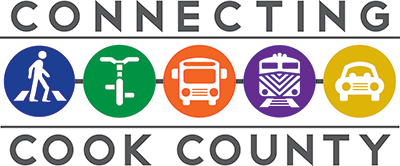FAQ's
What is a Long Range Transportation Plan?
A Long Range Transportation Plan, or LRTP, is a document that outlines a regional vision and strategy to address the area’s long-term transportation needs. The LRTP is developed through a cooperative transportation planning process designed to foster involvement by all users of the system, such as the business community, community groups, environmental organizations, the traveling public, freight operators, and the general public. The LRTP will evaluate current and future year conditions (through the year 2040) and will identify and prioritize transportation improvements and supporting policies.
Why is Cook County developing a LRTP?
Cook County is home to more than half the region’s population, businesses and jobs. The County is the second most populous county in the United States and its population is expected to increase another 24% by the year 2040. If we don’t plan for the transportation infrastructure needed to accommodate this growth it could adversely impact economic growth and quality of life. The Cook County LRTP provides an opportunity for the County to evaluate the current and future year transportation needs and ultimately identify priority improvements that keep pace with continued development.
Will the LRTP only include roadway improvements?
The plan will include roadway improvements but it will also identify opportunities to enhance public transportation, walking, and biking. The plan will also identify improvements to more efficiently move freight within Cook County, enhancing regional freight connections that can support local businesses and economic development. Ultimately, this plan is about finding the best solutions to move people and goods quickly and safely.
Didn’t CMAP recently complete a LRTP that included Cook County?
The Chicago Metropolitan Agency for Planning (CMAP) is responsible for preparing a long range transportation plan for the seven-county Chicago region (referred to as GO TO 2040). This document provides a high-level evaluation of the regional transportation system, whereas the Cook County LRTP will allow a more detailed evaluation of the County’s travel modes – roadways, rail transit, bus transit, biking. Ultimately, the Cook County LRTP recommendations will be incorporated into the next update of the CMAP regional LRTP which will lead to a stronger, coordinated regional planning effort.
How will Cook County’s LRTP address other plans such as CTA, Metra, and Pace?
CTA, Metra, Pace, along with many of the municipalities that make up Cook County, have similar long range plans that outline a vision, priority improvements, and implementation strategy. The Cook County LRTP will build upon existing plans to identify opportunities to coordinate planning efforts with the goal of implementing regional transportation investments that will benefit all agencies, but more importantly increasing the mobility options for area residents. One goal is to identify consensus projects that participants can pursue under federal competitive/discretionary funding programs so that we grow the resources flowing to the region.
Has Cook County ever produced a LRTP before?
The last time the County produced a long range plan was in 1940. That plan laid out what eventually became our regional expressways. The I-57, Bishop Ford, Dan Ryan, Stevenson, Eisenhower, Kennedy, Jane Addams, Edens and Tri-State expressways were built pretty much according to that plan. Today, Cook County is committed to creating a new long-range plan that modernizes and expands our transportation options to meet the future needs of our residents and businesses.
What’s involved in preparing a long range transportation plan?
The LRTP process can be summarized in the following steps:
- Develop a Vision Statement. The vision statement will guide the overall evaluation and study process.
- Analyze existing conditions and future needs. The LRTP will analyze the current our transportation system to identify issues, deficiencies, and gaps. The plan will also look out to the year 2040 to identify what transportation improvements will be needed to accommodate forecasted population and economic growth.
- Evaluate alternatives. Based on the current and future year needs, the LRTP will identify and evaluate a range of potential transportation improvements that will enhance area businesses and communities.
- Develop a Recommended Plan. The LRTP will include a list of capital projects, based in part on public input, and policy recommendations that will support implementation.
- Financial Analysis. The LRTP will determine what the recommended plan costs and will identify potential funding scenarios to implement the projects
Will the public have an opportunity to participate in the planning effort?
Public input is a critical piece of the planning process and there will be multiple opportunities to participate. A project website will provide up-to-date information on the study and allow the opportunity to provide feedback. An interactive planning software (MetroQuest) will also be used to allow the public to tell us what’s working well—and not so well—and to see the impact of their choices via maps, graphs and charts. We will also use social media to share information and get feedback but we also plan to use more traditional methods, such as public meetings and a quarterly electronic newsletter to share information and obtain feedback that will help shape the plan.
When will the final LRTP be ready?
The final plan will be presented to the Cook County Board of Commissioners in June 2016.
